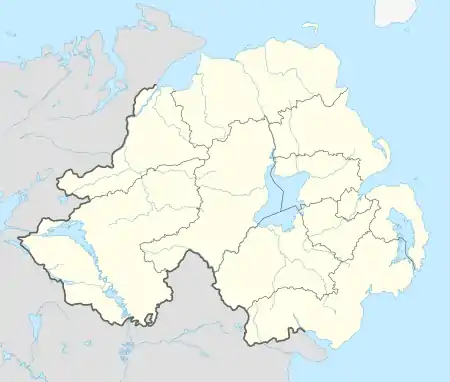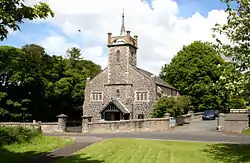Armoy, County Antrim
Armoy (from Irish: Oirthear Maí)[2] is a village and civil parish in County Antrim, Northern Ireland. It is 5.5 miles (9 km) southwest of Ballycastle and 8 miles (13 km) northeast of Ballymoney. According to an estimate in 2013 by the Northern Ireland Statistics and Research Agency it had a population of 1,122.[3]
| Armoy | |
|---|---|
 St Patrick's Church and the round tower | |
 Armoy Location within Northern Ireland | |
| Population | 1,122 (2013 Estimate) |
| Irish grid reference | D067328 |
| • Belfast | 49 mi (79 km) |
| District | |
| County | |
| Country | Northern Ireland |
| Sovereign state | United Kingdom |
| Post town | BALLYMONEY |
| Postcode district | BT53 |
| Dialling code | 028, +44 28 |
| UK Parliament | |
| NI Assembly | |
The village is centred on the River Bush and at the foot of two of the nine Glens of Antrim; Glenshesk and Glentaisie. The Armoy parish also includes part of Knocklayd mountain which lies to the northeast of the village.[4]
It is one of the bigger villages in the area and has two primary schools, shops, a post office, public houses and other community facilities. The village was dominated by public sector housing for many years, but in the late 1980s and early 1990s, new housing developments began around the village.
The village is close to a number of scenic locations including the Dark Hedges, which in recent years has become a popular tourist attraction as the infamous "King's Road" in the HBO series Game of Thrones.[5]
History
A monastic settlement which was founded by Saint Patrick in the 5th Century formerly sat to the northeast of the present day village, in the area of what is now St. Patrick's Parish Church. The site was excavated in recent years and archaeologists uncovered artifacts which date the location to the 6th century. The actual centre of the monastic settlement has yet to be determined, though many scholars believe it may be higher up the slope behind the graveyard on unexcavated ground.
The monastic settlement is said to be built on land given to Patrick by Fergus Mor MacEarca who would succeed his father to become the first Christian king in Ireland. Saint Olcán was a follower of Patrick who came from the area, and was baptised at Dunseverick by Patrick and later became Bishop of Armoy. One of the local primary schools still carries his name.[6]
It is suggested that the original site of the village was built around the monastery and the round tower. However the village moved to its present-day location on the banks of the River Bush to accommodate the local mills which demanded large volumes of water. Therefore, a location by the riverbank was much more suitable.
The area surrounding the present day church is of special significance as it has several oval shaped tunnels which have been dug under the rock all the way down to a cave at the Lagge crossroads below the church. This tunnel from the tower to the crossroads was used as an escape route as it leads down to the River Bush. The word Lagge is of significance as it translates as hollow and legend has it that a giant lifted an ‘L’- shaped section of the ground at Lagge Cross and threw it into the sea creating Rathlin Island.[7]
Places of interest
- A picturesque Presbyterian Church sits near to the edge of the River Bush and not to far from the centre on the village. The church’s striking spire, with a Viking ship weathervane on top, has been described as ’a miniature replica of the Eiffel Tower’.

- There are the remains of an Irish round tower on the edge of the village. An early monastery was founded about AD 460 by Saint Olcán, a disciple of Saint Patrick. The only trace of an early monastery is the stump of the round tower, which stands in the grounds of St Patrick's Parish Church. The tower is about 11 m high and has three storeys. At one time, Armoy was the main religious settlement in the Irish part of the kingdom of Dál Riata.
- Close to the village is Gracehill House, a Georgian house dating from 1775. The grounds are home to Gracehill Golf Course, an 18-hole parkland golf course which is surrounded by ponds and woodland. It was designed with challenging obstacles such as water hazards and large trees; some of the greens are strategically placed near water hazards while other holes are played through mature woodland or over heathland, making Gracehill one of the few courses in Ireland to offer such variety.[8]
- The village also has a small park beside the river in which many references can be found to its connection with motorbikes and road racing. This includes a monument dedicated to the "Armoy Armada" who were a famous group of road racers from Armoy which included Joey Dunlop, Mervyn Robinson, Frank Kennedy and Jim Dunlop.[9] The park also has paths laid out in the shape of the circuits of both the North West 200 and the legendary Isle of Man TT.
Events
In recent years Armoy has played host to what has become one of the stand out events in the Irish Road Racing calendar, The Armoy Road Race, also known as "The Race of Legends".[10]
The event was first ran in 2009 and usually takes place at the end of July/start of August every year. The track itself is 3 mile long circuit made up of public roads and runs through a part of the village. The grid for the races is set up in a grand prix style with up to 27 riders starting each race. The start/finish line is located along the A44 Hillside Road just to the north of the village on the main road to Ballycastle.[11]
Community development
The commercial and community life of the village has been greatly enhanced by a community regeneration project at the junction of Main Street and Drones Road. The Tilley Molloy Project, implemented under the International Fund for Ireland’s Community Regeneration and Improvement Special Programme (CRISP), was undertaken by Armoy Community Development Association and completed in 2000. This redevelopment of a key derelict site at the entrance to the village provided four shop units, four apartments, community care facilities and public toilets. The physical environment of the village has been further enhanced by a new Riverside Park developed by the District Council, and an environmental improvement scheme on Main Street carried out as part of the CRISP project.
Geography
Armoy is situated in the picturesque Glens of Antrim, an area renowned for its valleys shaped by glaciers during the ice age.[12] The Armoy Moraine is located on the outskirts of the village in an area known locally as The Lagge, where the Round Tower and St. Patrick's Church now sit. Deposited here as a result of the last glacial event in Ulster it deflected the River Bush to west, blocking its previous path northwards to the sea at Ballycastle. Today the River Bush now flows west through the village, towards Stranocum and eventually reaches the sea through Bushmills and Portballintrae.
Transport
Armoy railway station opened on 18 October 1880 and was shut on 3 July 1950.[13] It was on the Ballycastle Railway, a narrow gauge railway which ran for 17 miles linking Ballycastle to Ballymoney, on the Belfast and Northern Counties Railway (BNCR), later Northern Counties Committee (NCC), main line to Londonderry.[14]
The Troubles
On 15 April 1978 RUC officer John Moore was killed by an IRA booby trap bomb attached to his car.[15]
People
- John Armoy Knox, journalist, was born on 10 August 1851 at Armoy, the son of Thomas and Jane McBride Knox. His father and his uncle owned the Armoy Flax and Grain Mills. He emigrated to the United States in 1871 and settled in Austin, Texas working as a journalist, before editing newspapers in New York and Atlanta. He was also a playwright and author. He died suddenly in New York on 18 December 1906.
- Olcan McFetridge was a famous County Antrim hurler. He received an all-star award in 1989 and won a Sports Council Merit and Sunday Life Award in August 2005.
- Joey Dunlop OBE was a resident of Armoy and was a member of The Armoy Armada. He was a world champion motorcyclist.
- Steve & Charlie McCooke, Legendary cross country runners and Olympians. Stephen trained in his spare time while working on a farm and went on to compete in the 1948 Olympic Games in London. He was also a leading light of East Antrim Harriers cycling club. Hundreds of mourners, including sports officials from all over Ireland, gathered at 2nd Broughshane Presbyterian Church to say their farewells to Stephen Hunter McCooke, who with his brother Charlie captured virtually every track and field record in Ireland.
See also
- List of civil parishes in County Antrim
References
- Reynolds, Charlie. "The Aul' Hand". Ulster-Scots Academy. Retrieved 11 May 2017.
- Placenames Database of Ireland
- http://www.ninis2.nisra.gov.uk/public/AreaProfileReportViewer.aspx?FromAPAddressMulipleRecords=Armoy@Exact%20match%20of%20location%20name:%20@Exact%20Match%20Of%20Location%20Name:%20%20Armoy@4?
- "Parish of Armoy". Townlands.ie.
- "Dark Hedges - Game of Thrones". Discover Northern Ireland.
- http://www.causewaycoastalroute.com/armoy.html
- http://www.armoy.net/index.php/about/about
- "Gracehill House & Golf Club".
- http://www.amrrc.com/armoy-armada
- "Archived copy". Archived from the original on 30 July 2014. Retrieved 22 September 2014.CS1 maint: archived copy as title (link)
- http://www.amrrc.com/track-facts
- "Armoy Geology".
- "Armoy station" (PDF). Railscot - Irish Railways. Archived (PDF) from the original on 26 September 2007. Retrieved 8 September 2007.
- Baker, Michael HC (1999). Irish Narrow Gauge Railways. A View from the Past. Ian Allan Publishing. ISBN 0-7110-2680-7.
External links
- North Antrim.com - Armoy
- Armoy tourist and sports information
- The Northern Ireland Guide: For information on Armoy Round Tower and other historical attractions
- The McGoogans of Armoy
- Pride of the Park Flute Band - Armoy
- Ulster Scot - John Knox Armoy
- NI Neighbourhood Information System
- Armoy Presbyterian Church
- John Armoy Knox
- Moyle District Council - Armoy
- Megalithomania - Armoy Round Tower
- Armoy Round Tower
- Lewis's Topographical Dictionary, 1842
- Culture Northern Ireland
